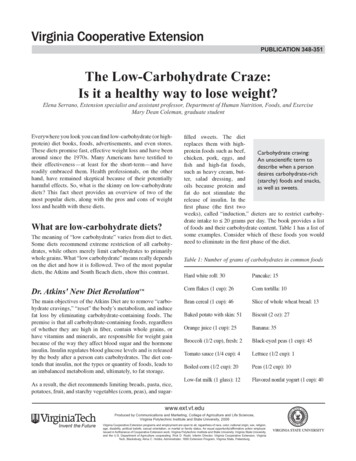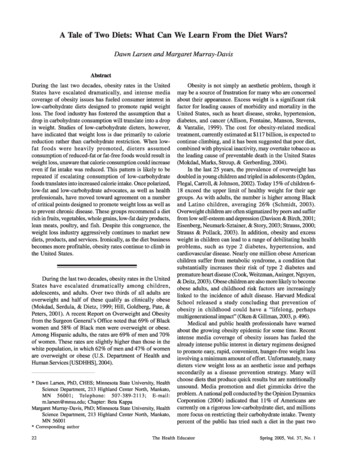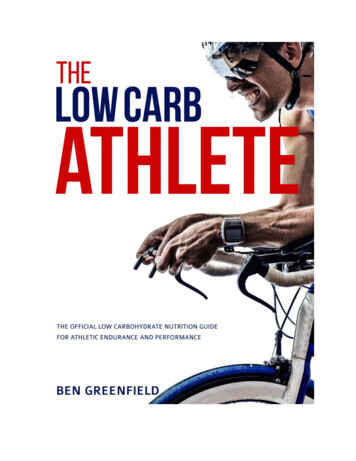
Transcription
publication 348-351The Low-Carbohydrate Craze:Is it a healthy way to lose weight?Elena Serrano, Extension specialist and assistant professor, Department of Human Nutrition, Foods, and ExerciseMary Dean Coleman, graduate studentEverywhere you look you can find low-carbohydrate (or highprotein) diet books, foods, advertisements, and even stores.These diets promise fast, effective weight loss and have beenaround since the 1970s. Many Americans have testified totheir effectiveness—at least for the short-term—and havereadily embraced them. Health professionals, on the otherhand, have remained skeptical because of their potentiallyharmful effects. So, what is the skinny on low-carbohydratediets? This fact sheet provides an overview of two of themost popular diets, along with the pros and cons of weightloss and health with these diets.What are low-carbohydrate diets?The meaning of “low carbohydrate” varies from diet to diet.Some diets recommend extreme restriction of all carbohydrates, while others merely limit carbohydrates to primarilywhole grains. What “low carbohydrate” means really dependson the diet and how it is followed. Two of the most populardiets, the Atkins and South Beach diets, show this contrast.Dr. Atkins' New Diet Revolution The main objectives of the Atkins Diet are to remove “carbohydrate cravings,” “reset” the body’s metabolism, and inducefat loss by eliminating carbohydrate-containing foods. Thepremise is that all carbohydrate-containing foods, regardlessof whether they are high in fiber, contain whole grains, orhave vitamins and minerals, are responsible for weight gainbecause of the way they affect blood sugar and the hormoneinsulin. Insulin regulates blood glucose levels and is releasedby the body after a person eats carbohydrates. The diet contends that insulin, not the types or quantity of foods, leads toan imbalanced metabolism and, ultimately, to fat storage.As a result, the diet recommends limiting breads, pasta, rice,potatoes, fruit, and starchy vegetables (corn, peas), and sugar-filled sweets. The dietreplaces them with highprotein foods such as beef,Carbohydrate craving:chicken, pork, eggs, andAn unscientific term tofish and high-fat foods,describe when a personsuch as heavy cream, butdesires carbohydrate-richter, salad dressing, and(starchy) foods and snacks,oils because protein andas well as sweets.fat do not stimulate therelease of insulin. In thefirst phase (the first twoweeks), called “induction,” dieters are to restrict carbohydrate intake to 20 grams per day. The book provides a listof foods and their carbohydrate content. Table 1 has a list ofsome examples. Consider which of these foods you wouldneed to eliminate in the first phase of the diet.Table 1: Number of grams of carbohydrates in common foodsHard white roll: 30Pancake: 15Corn flakes (1 cup): 26Corn tortilla: 10Bran cereal (1 cup): 46Slice of whole wheat bread: 13Baked potato with skin: 51Biscuit (2 oz): 27Orange juice (1 cup): 25Banana: 35Broccoli (1/2 cup), fresh: 2Black-eyed peas (1 cup): 45Tomato sauce (1/4 cup): 4Lettuce (1/2 cup): 1Boiled corn (1/2 cup): 20Peas (1/2 cup): 10Low-fat milk (1 glass): 12Flavored nonfat yogurt (1 cup): 40www.ext.vt.eduProduced by Communications and Marketing, College of Agriculture and Life Sciences,Virginia Polytechnic Institute and State University, 2009Virginia Cooperative Extension programs and employment are open to all, regardless of race, color, national origin, sex, religion,age, disability, political beliefs, sexual orientation, or marital or family status. An equal opportunity/affirmative action employer.Issued in furtherance of Cooperative Extension work, Virginia Polytechnic Institute and State University, Virginia State University,and the U.S. Department of Agriculture cooperating. RIck D. Rudd, Interim Director, Virginia Cooperative Extension, VirginiaTech, Blacksburg; Alma C. Hobbs, Administrator, 1890 Extension Program, Virginia State, Petersburg.
Carbohydrate-containing foods that are allowed includesome vegetables and leafy greens. After two weeks, dieters can increase their carbohydrate intake by 5 grams perweek until weight loss stops and then start to increase by10-gram increments as weight maintenance is sustained.Other foods allowed over time include some nuts, berries, andvegetables.terol, in long-term studies.Although low-carbohydrate(high-protein) diets typically include foods high insaturated fat and cholesterol, to date, studies haveindicated that they do notpositively or negativelychange total cholesterol,LDL cholesterol, or HDLcholesterol in short-termstudies. These diets dohave a positive impact ontriglycerides. Levels wentdown in all reported studies. High triglycerides incombination with low HDLcholesterol levels are riskfactors for heart disease.The South Beach Diet Similar to Atkins, the South Beach Diet also focuses on removing “carbohydrate cravings” and promoting weight loss byremoving carbohydrates andallowing high-protein, highfat foods during the first twoLow-glycemic index:weeks. Unlike the AtkinsA scientific term meaningdiet, the South Beach Dietthat it takes longer todoes not limit carbohydratebreak down carbohydratesintake or allow unlimitedin the food into simpleconsumption of high-prosugars so they can entertein, high-fat foods afterthe blood stream.the first two weeks. Instead,carbohydrates are “re-introduced” with a modified dietthat includes small portions of carbohydrates, such as wholegrain products (breads, cereals, and pastas), that are high infiber and have a “low-glycemic index.” The diet also encourages proper portion sizes and high-fiber vegetables and nuts.LDL “Bad” cholesterol;High LDL linked to higherrisk of heart diseaseHDL “Good”cholesterol; High HDLlinked with lower risk ofheart diseaseSee Know Your CholesterolNumber, VirginiaCooperative Extensionpublication 348-018, formore information.In this case, weight loss, not the saturated fat andcholesterol in the diet, may be the reason that cholesterolis not changed. It is unclear what would happen tocholesterol levels if the diet were followed over anextended period of time.What are the disadvantages?There are several questions and concerns raised about lowcarbohydrate diets that you should be aware of before startinga low-carbohydrate diet.What are the benefits?Weight LossOne of the biggest benefits of low-carbohydrate (high-protein)diets is short-term weight loss. This is one reason that theyhave been so successful. In fact, compared to a traditionallow-fat, high-carbohydrate, low-calorie diet, these diets havebeen shown to result in greater weight loss in studies lastingless than six months. In a few studies carried out for one year,dieters on the Atkins diet lost more initial body weight compared to the low-fat group and at the end of six months. At oneyear, however, the Atkins diet group gained back more weightcompared to the low-fat diet group with the end weight lossbeing similar for the two groups at the end of the studies.What foods are not part of low-carbohydrate diets?One of the biggest concerns with restrictive, low-carbohydrate diets is the elimination of certain foods and food groups.There are definitely some foods in each food group that offermore nutrients than others, such as whole-grain foods versusrefined grains like white bread and sweet rolls. Still, thereare numerous studies showing that healthy choices and sensible portion sizes from all of the food groups of the FoodGuide Pyramid, combined with physical activity, help achievea healthy weight – and promote lifelong health. Protein andfat alone cannot provide you with the nutrients you need forgood health, which is not necessarily the same thing as weightloss. Vitamin and mineral supplements are just that – “supplements” – and should not be used as replacements. They donot offer the same benefits as vitamins and minerals obtainedfrom “real” foods.Many scientists argue that the short-term greaterweight loss for individuals on the Atkins diet is due tofewer calories, not necessarily because of the lack ofcarbohydrates. Weight loss may also be in the form ofmuscle, not fat.Following is a list of some of the nutritional benefits that arelost as a result of restrictive carbohydrate diets:CholesterolDiets high in saturated fat and dietary cholesterol are known toraise LDL, “bad” cholesterol, and lower HDL, “good” choles2
Breads, cereals, and grains – especially whole grains – provide excellent sources of fiber and B vitamins, like folic acid,which helps promote heart health and prevent childbearingwomen from having babies with neural tube defects.a diet that is lower in carbohydrates than is recommendedby the Food Guide Pyramid. Even among these individuals, just as with the general population, carbohydrates andinsulin are not the culprits. Overweight is typically the maincontributor, combined with lifestyle behaviors. Typically theside effects are eliminated with weight loss and/or physicalactivity – without the need to heavily restrict or avoid carbohydrates altogether, but rather replacing refined grains withwhole grains and foods high in fiber. Carbohydrates are the best source of energy for yourbrain and body, especially if you are active. Protein andfat are not as efficient sources of energy; they need to beconverted into energy units that you can use. Many peoplecomplain about being fatigued and getting headaches onlow-carbohydrate diets because of this.ConstipationConstipation is a common problem for people following lowcarb, high-protein diets. Fruits, vegetables, and whole grainsprovide significant sources of fiber that help maintain regular bowel function. The Atkins diet is not recommended forindividuals with chronic gastrointestinal (GI) diseases suchas Crohn’s, irritable bowel syndrome (IBS), or diverticulitis.Persons with GI diseases need dietary fiber to maintain regular bowel function and to prevent flare ups. Fruits and vegetables are rich sources of fiber, vitamins,minerals, and phytochemicals that help protect againstdisease. Fruits, despite their numerous benefits, are notrecommended in low-carbohydrate diets because theynaturally contain sugar. Dairy products are excellent sources of calcium and vitamin D for strong bones and teeth, but because they alsocontain natural sugars, they are also avoided in manydiets.Cancer and Heart DiseaseFruits, vegetables, and whole grains contain many vitamins,minerals, phytochemicals, and antioxidants that repeatedlyhave been shown to reduce risk for many cancers and heartdisease. Low-carb, high-protein diets severely limit theamount of fruits, vegetables, and whole-grain foods you are“allowed” to eat. Plant-based foods are the best choices fordisease prevention. Nuts provide healthy sources of fat, such as omega-3 fattyacids, which help protect against heart disease. Fiber, which is found in most of the foods that are eliminated in low-carbohydrate diets, helps give you the feelingof being full.Are all fats and high protein foods created equally?Bone LossCalcium is an important mineral for bone health. Inadequateintakes of calcium have been associated with osteoporosis, adisease in which the bones become extremely fragile. Highlevels of protein have been shown to increase calcium lossfrom the body, calcium which is thought to come from bone.Nevertheless, short-term studies that measured markers ofbone breakdown found high-protein diets do not cause bonebreakdown when you consume enough calcium. The recommended intake for adults up to age 50 is 1000 mg of calciumper day and 1200 for those 50 and over. Again, it is unclear ifbone health would be impacted over time with high-proteindiets.Although many of the low-carbohydrate diets stress theimportance of eating proteins and not worrying about fat, itis important to distinguish between healthier and unhealthierchoices. High-fat meats, heavy cream, butter, and gravy contain saturated fat and cholesterol, which can contribute to anelevated risk of heart disease. Try to limit saturated fat bychoosing lean meats or beans, low-fat dairy products, andfish and nuts that are high in omega-3 fatty acids, consideredbeneficial for the heart.The ScienceBehind the DietUnfortunately, many popular diets interpret theexisting research and usescientific terms inappropriately to justify their booksand programs. For example,some people suffer frominsulin resistance or Syndrome X and benefit fromSyndrome X is a termused for someone whois overweight and has:an apple shape; raisedblood pressure; and hightriglycerides.Kidney FunctionKidneys are the main organs responsible for eliminating theby-products of protein metabolism. Many researchers havehypothesized that eating high amounts of protein would putexcess strain on the kidneys, which may ultimately reduce kidney function. To date, there is no proof that high-protein dietscause kidney disease or poor kidney function. However, if aperson already has poor kidney function as a result of untreatedor poorly controlled hypertension, for example, thenA person who is insulinresistant respondssluggishly to insulin.3
a high protein diet may cause further kidney damage and is notrecommended. You should consult a physician before considering this diet if you have high blood pressure or suspect kidneydamage. There is no legal definition for “low-carb” foods, meaningthat manufacturers can put a “low-carb” label on any foodproduct they make. Low-carb does not equal no calories. Many low-carb itemsare high in calories. For example: A one-ounce low-carbcandy bar has 150 calories – similar to a regular candy bar.If eaten daily, these calories can add up over time and leadto weight gain.Sports PerformanceCarbohydrate is the primary fuel that the muscles and thebrain use for energy. Diets low in carbohydrates can causemuscle weakness, confusion, dizziness, tiredness, and dehydration—making physical activity less enjoyable. Individuals who participate in endurance activities (activities lastingmore than one hour) should not consume low-carbohydrate,high-protein diets. Carbohydrates are replaced with protein, fat, or sugar alcohols. Per gram, protein has the same amount of caloriesand fat has double the calories of carbohydrate. Low-carbitems typically will have either more or the same numberof calories as the same food item that is not low-carb.Boredom Level The sugar alcohols found in low-carb candy, ice cream,soda, shakes, etc. can cause bloating, cramps, and diarrhea.Lack of variety in food choices and boredom, particularlywith the Atkins diet, is a common reason individuals areunable to remain on the low-carbohydrate diets and keep theweight off for the long-term. There are no scientific definitions for the claims of “netimpact” or “effective carbs.” It is not even clear what thesemean.When should low-carbohydratediets be completely avoided? Cost! Low-carb products are very expensive. A one-ouncecandy bar is 1.00, a seven-ounce box of mashed potatoes is 6.99, and four servings of Atkins ice cream is 5.00.Highly restrictive low-carbohydrate diets, such as Atkinsand the first phase of the South Beach diet, are not appropriate during pregnancy and lactation or in childhood or the preteen or teen years. During these periods of life, growth is veryrapid and the body requires calories and several nutrients,such as calcium, folate, and vitamin A, to promote optimaldevelopment. Restricting calories and these nutrients couldlead to poor growth during these critical years. These dietsmay hinder the production of breast milk during lactation.The diets also lack dietary fiber which could contribute toconstipation, a common problem during pregnancy. Finally,sudden cardiac arrest has also been reported among a fewindividuals on these diets. Consult your doctor or a dietitianbefore considering a low-carbohydrate (high-protein) diet. Menus with low-carb food items do not list the numberof grams of carbohydrate. Many meals contain at least12 grams of carbs—more than half of the recommendednumber for the induction phase of the Atkins diet. Most low-carb products taste worse than their higher-carbreplacements.What are the most effectiveand healthy approaches to weightloss?Low-carb Foods: Buyer BewareHealth professionals need more long-term studies beforethey can fully endorse low-carbohydrate diets for weight lossand long-term health benefits, even though the diets may beuseful to initiate weight loss. If you choose to go on a lowcarbohydrate diet, do so for only a short period of time. Then,incorporate whole-grains, fruits, and vegetables to maintainyour weight, to increase the variety in your diet, and to minimize any potentially negative health effects like cancer orosteoporosis. The variety of foods will also provide the nutrients you need for good health.The low-carb diet mania has increased the demand for lowcarbohydrate products. In response, many companies havestarted to produce low-carb food items. Restaurants are alsointroducing new low-carb menus. Consumers increased theirspending on low-carb food items from 79 million in 2000 to 334 million in 2003. People should be aware that low-carb,like the low-fat “Snackwell Revolution” in the ’80s, does notmean “all-you-can-eat.” If you decide to follow a low-carbdiet for even a short period of time, consider carefully thepros and cons of these newly advertised products when planning your meals and snacks.Drastic dietary measures, such as low-carb diets, however,are not needed to lose weight. Research shows that small4
changes can result in big impacts over time. Here are somesimple ways to lose weight:Other ResourcesFor more information on related topics, visit the VirginiaCooperative Extension Web site at www.ext.vt.edu Aim for no more than one to two pounds of weight loss perweek.Other related publications Watch portion sizes. Portion distortion is a major reasonfor the expanding waistlines in America.Know Your Cholesterol Number, Virginia CooperativeExtension Publication 348-018 Replace refined cereals like white bread and rolls withwhole-grain products like 100% whole wheat bread andpasta and oatmeal.Calcium Checklist: Build Strong Bones, Virginia CooperativeExtension Publication 348-019Here’s To Your Family’s Health, Virginia CooperativeExtension Publication 348-025 Eat “5 to 9” a day of fruits and vegetables. You can eatmore for the same number of calories.The Food Guide Pyramid and Dietary Guidelines, VirginiaCooperative Extension Publication 348-710 Eat a variety of foods, from all of the food groups. Do noteliminate any food group to lose weight; instead chooselow-fat or healthier options in each group.References Choose healthy drinks, such as water, low-fat milk, or100% juice. Fruit drinks and soda provide empty calories– meaning calories without nutrients.Atkins R. Dr. Atkins' New Diet Revolution. 3 ed. AvonBooks: New York. 2002.rd Be active. Physical activity is not only a successful way tolose weight, but to maintain weight loss. It also improvesyour overall physical and mental health. Aim for at least30 minutes each day. Any movement can count: walking,biking, swimming, and yoga. Choose something you enjoydoing.Agatston A. The South Beach Diet. 1 ed. Rodale Books:USA. 2003. Get social support from family and friends. Encouragethem to provide positive feedback for your weight lossefforts.Samaha, F., Iqbal, N., Seshadri, P., et al. A low-carbohydrateas compared with a low-fat diet in severe obesity. NewEngland Journal of Medicine. 2003;348:2074-2081. Provide yourself with non-food rewards for meeting small,defined goals.Roughead, Z., Johnson, L., Lykken, G., et al. Controlledhigh meat diets do not affect calcium retention or indicesof bone status in healthy postmenopausal women. Journalof Nutrition. 2003, 133:1020-1026.stFoster, G., Wyatt, H., Hill, J., et al. A randomized trial of alow-carbohydrate diet for obesity. New England Journalof Medicine. 2003;348:2082-2090.Rapuri, P., Gallagher, J., Haynatzka, V. Protein intake:effects on bone mineral density and the rate of bone lossin elderly women. American Journal of Clinical Nutrition.2003;77:1517-1525.Times & Trends Executive Summary. “Chasing the LowCarb Consumer.” Grocery Manufacturers of America, Inc.January 2004.5
on the diet and how it is followed. Two of the most popular diets, the Atkins and South Beach diets, show this contrast. Dr. Atkins' New Diet Revolution The main objectives of the Atkins Diet are to remove "carbo-hydrate cravings," "reset" the body's metabolism, and induce fat loss by eliminating carbohydrate-containing foods. The










